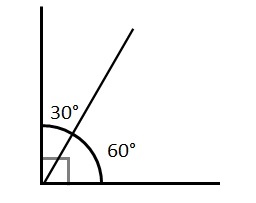Complementary Angles
(KS2, Year 6)
 Two angles that add to 90° are are said to complement each other.
Two angles that add to 90° are are said to complement each other.A Real Example of Complementary Angles
Angles of 30° and 60° are complementary angles.
30° + 60° = 90°

How to Find a Complementary Angle
Question
What is the missing angle θ below?
Step-by-Step:
1
The 53° angle and θ are complementary angles. They add up to 90°.
53° + θ = 90°
2
Subtract the 53° angle from 90°.
θ = 90° − 53° = 37°
Answer:
The missing angle θ is 37°.Top Tip
What Types of Angles Are Complementary?
Complementary angles form a Corner.Note
What's In an Name?
Complementary comes from the Latin word "complementum" meaning "fill up, complete, supply. This is because an acute angle is filled up to form a right angle. We get the word "complete" from the same root. Don't confuse a complementary angle with a complimentary angle; which would be a free angle or an angle giving praise.Complementary Angles Are Acute Angles
Both complementary angles are less than 90°, and so are acute angles.Worksheet
This test is printable and sendable






